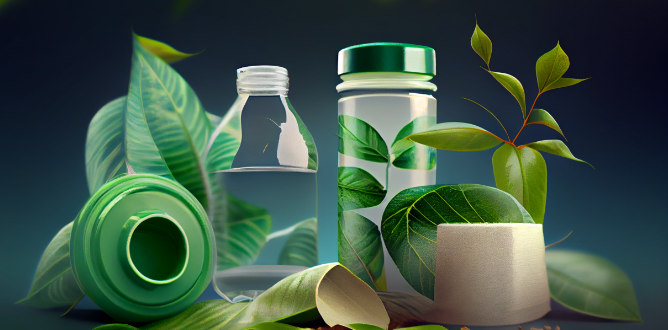The Role of Bioplastics in Sustainable Product Design: A Step Toward a Greener Future
In recent years, the environmental impact of conventional plastics has sparked growing concerns worldwide. Derived from fossil fuels, traditional plastics contribute significantly to pollution, greenhouse gas emissions, and overflowing landfills. To address these issues, industries and researchers are turning to bioplastics as a sustainable alternative, particularly in the realm of product design. Bioplastics, created from renewable resources, offer a promising solution for reducing the ecological footprint of consumer goods.
This article explores the role of bioplastics in sustainable product design, highlighting their benefits, applications, and future potential in building a more environmentally friendly world.
What Are Bioplastics?
Bioplastics are a category of plastics derived from renewable biological sources such as corn starch, sugarcane, potato starch, or even algae. Unlike conventional plastics, which are made from petroleum, bioplastics are designed to be biodegradable, compostable, or recyclable, depending on their formulation.
Bioplastics can be classified into two main categories:
- Biobased Plastics: Made entirely or partially from renewable resources but not necessarily biodegradable. Examples include biobased polyethylene (PE) and polyethylene terephthalate (PET).
- Biodegradable Plastics: Capable of decomposing naturally into water, carbon dioxide, and biomass under specific conditions. Examples include polylactic acid (PLA) and polyhydroxyalkanoates (PHA).
The Importance of Sustainable Product Design
Sustainable product design aims to minimize the environmental impact of a product throughout its lifecycle—from raw material extraction to disposal. This approach emphasizes resource efficiency, reduced waste, and the use of eco-friendly materials. Bioplastics align perfectly with these principles, offering designers the opportunity to create products that are both functional and sustainable.
Benefits of Bioplastics in Sustainable Product Design
Integrating bioplastics into product design offers several environmental and economic advantages:
1. Reduced Carbon Footprint
Bioplastics are produced from renewable resources that absorb carbon dioxide during growth, offsetting the emissions generated during production. This results in a lower carbon footprint compared to traditional plastics.
2. Biodegradability and Compostability
Many bioplastics are designed to break down naturally, reducing the accumulation of plastic waste in landfills and oceans. Compostable bioplastics further contribute by enriching soil when disposed of correctly.
3. Resource Conservation
By replacing fossil fuels with renewable resources, bioplastics contribute to the conservation of non-renewable resources and promote sustainable practices.
4. Consumer Appeal
Eco-conscious consumers are increasingly demanding sustainable products. Using bioplastics enhances brand reputation and demonstrates a commitment to environmental responsibility, attracting a growing market segment.
5. Versatility in Applications
Bioplastics offer a wide range of properties, including flexibility, durability, and transparency, making them suitable for various applications in packaging, electronics, automotive components, and more.
Applications of Bioplastics in Sustainable Design
Bioplastics have found applications across multiple industries, driving innovation in sustainable product design.
1. Packaging
Bioplastics are widely used in sustainable packaging solutions, including food containers, shopping bags, and beverage bottles. For example, PLA and PHA are commonly employed to create biodegradable packaging that reduces plastic waste.
2. Textiles and Fashion
In the fashion industry, bioplastics are used to produce eco-friendly fibers and accessories. For instance, biobased polyesters are used to create sustainable clothing and footwear.
3. Electronics
Bioplastics are being integrated into electronics, such as smartphone casings and circuit boards, to reduce the environmental impact of e-waste.
4. Automotive Components
The automotive industry is embracing bioplastics to manufacture lightweight, sustainable components such as interior panels, trims, and upholstery. This reduces the vehicle’s overall weight and improves fuel efficiency.
5. Medical Devices
Bioplastics like PLA and PHA are used in biodegradable medical implants, drug delivery systems, and packaging for pharmaceuticals, ensuring both functionality and environmental safety.
Challenges in Using Bioplastics
Despite their potential, bioplastics face several challenges that must be addressed to ensure widespread adoption:
- Higher Production Costs
Bioplastics are often more expensive to produce than conventional plastics due to limited economies of scale and specialized manufacturing processes. - Limited Infrastructure for Disposal
Biodegradable and compostable bioplastics require specific conditions for decomposition, such as industrial composting facilities. The lack of widespread infrastructure can hinder effective waste management. - Competition for Resources
Producing bioplastics from agricultural crops raises concerns about competition for land and resources that could otherwise be used for food production. - Material Performance
Some bioplastics may not match the durability or heat resistance of traditional plastics, limiting their usability in certain applications.
Future Prospects of Bioplastics in Product Design
The future of bioplastics in sustainable product design looks promising, driven by advancements in technology and increasing consumer demand for eco-friendly solutions. Key trends include:
- Development of Second-Generation Bioplastics: Research is underway to create bioplastics from non-food biomass, such as agricultural waste, algae, and cellulose, reducing the strain on food resources.
- Improved Material Properties: Innovations in material science are enhancing the performance and versatility of bioplastics, making them competitive with traditional plastics.
- Circular Economy Integration: Bioplastics will play a crucial role in building a circular economy, where materials are reused, recycled, or composted to minimize waste.
- Policy and Regulation Support: Governments are introducing policies and incentives to encourage the use of bioplastics, fostering their adoption in various industries.
Conclusion: Bioplastics as a Cornerstone of Sustainability
Bioplastics are transforming sustainable product design by providing an eco-friendly alternative to conventional plastics. Their renewable origins, biodegradability, and versatility make them a valuable asset in reducing the environmental impact of consumer goods. While challenges remain, ongoing research and innovation are paving the way for bioplastics to become a mainstream solution in the fight against plastic pollution.
By embracing bioplastics, industries can not only meet the growing demand for sustainable products but also contribute to a greener, more sustainable future for generations to come.

Also Read :
- High-Performance Computing in Chemical Engineering Simulations
- Bridging the Gap: Engineering Research in Affordable Housing
- Revolutionizing Agricultural Engineering with Robotics
- Exploring New Materials for Space Exploration: An Engineering Perspective
- Hydrogen Fuel Cells: Engineering Cleaner Energy Systems
